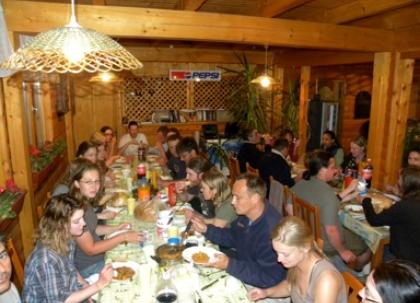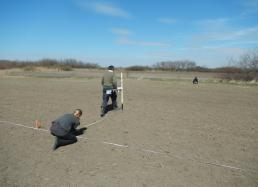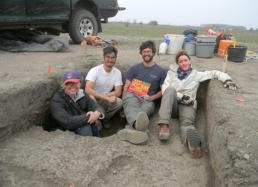4. "Sok minden történik!" (There’s a lot going on!)
There is a lot going on! We currently have six different teams working in the field, and our number has swelled to over thirty. The dinner table has expanded considerably!
Last Friday, the entire team headed up to Budapest, where Attila presented a paper about the project. The conference was a great opportunity to meet with archaeologists from all over southeastern Europe who specialize in the Neolithic and Copper Age. Our paper was very well received, and it was helpful to exchange ideas with other people who focus on the region.
Everyone at the conference agreed that there’s a lot of great work going on, and that the end of the Neolithic—the beginning of the fifth millennium BC—is getting more and more interesting as we collect more data. The trip to Budapest also was a good opportunity for the team to have a couple days in the big city and away from the field, as we hadn’t had a day off since the season began.
On Sunday at the airport, we picked up the geophysical team members who arrived from Crete. This year, only Apostolos Sarris and Nikos Papadopoulos (Foundation for Research and Technology-Hellas, FORTH) joined us, because last year we received a grant from the Wenner-Gren Foundation that let Apostolos and Nikos train several Hungarian archaeologists in geophysical methods.
We’ve been working with “The Greeks” (as they’re known on our project) since 2001 and have a wonderful working relationship with them. Together, we’ve been combining different techniques and really pushing the envelope of archaeological geophysical prospection methods.
The basic principle of geophysics is to use a variety of non-invasive sensing techniques to identify differences (anomalies) that relate to natural features or cultural activity. With Apostolos and Nikos, we’ve been developing and refining several methods to explore the extent and organization of the tell settlements at Szeghalom-Kovácshalom and Vésztő-Mágor.
The technique that we’ve found most successful in determining settlement organization has been magnetometry, which I discussed at length last year in my second blog of the 2011 Season. We also used ground penetrating radar (GPR) in 2011, which was critical for identifying the location of the 1968 excavation trench of Kornél Bakay.
Last year, Apostolos and Nikos also brought two other colleagues—one from Italy who studies multispectral satellite data (7-10 bands on the electromagnetic spectrum), and the other from Cyprus, who uses a handheld, site-based device that measures hundreds of bands (hyper-spectral).
This year, we decided they should bring another piece of equipment that will let us examine geological and cultural features that go significantly deeper than those we could identify using magnetometry. The technique, which is called Electrical Resistance Tomography (ERT), explores the landscape using an electrical current, and it reaches to a depth of about 10-11 meters (about 33-36 feet).
We wanted to try out the technique here to see if we could model the shape and depth of the ancient riverbeds that ran around the site during the Neolithic period. Now, since the ancient rivers have all dried up, and because they’ve been industrially plowed for nearly a hundred years, they’re heavily eroded and only visible on the topographic map that Dani Riebe made using the RTK GPS. By combining the ERT results with those from the geomorphological team from Budapest, who just arrived yesterday, we’ll be able to more accurately reconstruct the ancient environs of the site.
We also hope to extract pollen from the geomorphological cores, which will tell us about how the local flora changed throughout the last several thousand years. So, all in all, we currently have three geophysical teams (two doing magnetometry and one doing ERT), and the geomorphologists all working together to answer these important questions.
To report on other important accomplishments, Paul Duffy finished the excavation of the test trench in the western part of the site (Block W1B1), and took over the oversight of the Southeast Block (SE1B1) from Julia Giblin, who left from Budapest on Saturday. The thick, hard clay in that 10x10-meter (about 33x33-feet) excavation block is not being any more forgiving, but we’re starting to identify features—pits, postholes, and possible wall trenches—that will inform us about how the longhouse was built, and how it related to the rest of the settlement.
In the northern part of the site, the Hungarian excavation team has been hammering away—literally—at Block N1B1, where they’ve been removing the thick wall rubble from the southern portion of the longhouse. To our surprise, once the top daub layer was removed, we identified the impressions of several planks that were pushed into the clay floor under the house. We’ve still not been able to determine whether the planks were part of the floor, the walls, or the ceiling of the structure. But one thing is certain—we’re really fortunate to be working with such wonderful colleagues who are not only great people, but also top-notch excavators.
At the tell, Rick Yerkes and his team have discovered cultural layers that run even deeper than those that contained the preserved wood. The team has been cleaning back the profiles of the old excavation trench and preparing them for documentation and sampling. This will give us a good temporal dimension that will be essential for understanding how the settlement grew and expanded over time.
We’ve got just a little over a week to finish up everything left to be done—which is a lot! So we’ve kicked the season into overdrive, and all week we’ve been working non-stop from early morning until early evening. Normally, we try to balance our time between field work and analysis. The archaeological “rule” is that for every hour one works in the field, one has to put in 4-5 hours in the lab to study the material.
But this year, oddly enough, the structures we’re excavating haven’t been yielding very many finds, perhaps because they were emptied out before they were burned down. This has permitted us to focus on doing more fieldwork in the last couple days. But the ceramics, bone, stone tools, and other finds are beginning to build up, and we need to catch up in the lab.
A final piece of big news! One of our undergraduate students—Jacqueline Lipphardt (Ohio State University), who has been working with us for three years—just found out that she received a Fulbright scholarship to study in Hungary for nine months! We’re very proud of Jackie and are thrilled to see her moving forward in her studies with this prestigious fellowship.
As I mentioned, we have just over a week of fieldwork left, and we’re trying to move as fast as we can while the weather holds. It was in the 70s today, and we’re hoping the rain will continue to avoid us while we try to tie up loose ends.
Stay tuned!
Bill









